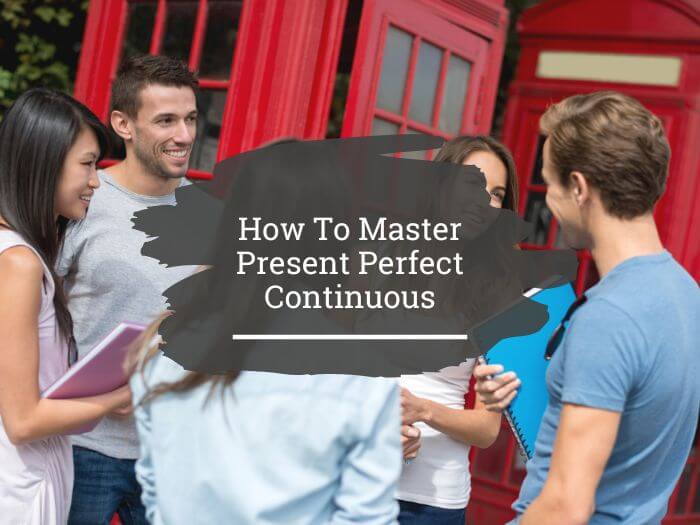


If you’re here, it means you want to learn about the present perfect continuous, a verb structure that we often use in English.
So, let me tell you everything you need to know about. How do we form the present perfect continuous? When do we use it? What differences are there between the present perfect continuous and the present perfect simple? What mistakes should you avoid when using it?
The present perfect continuous, also known as the present perfect progressive, is a verb structure we use to describe an action or activity that started in the past and is still connected to the present in some way.
Here's an example:
The action, “waiting”, started in the past (20 minutes ago) and is still in progress now. Jane is still waiting at the bus stop.
In English, you can't use the present simple “Jane waits” here as you can in other languages.
We'll get into how to use the present perfect continuous more later. For now, let's take a look at how to form it.
We form the present perfect continuous tense using “have/has been” plus the “ing” form of the main verb. Like this:
I’ve been working here for three years.
But let’s have a closer look at examples of present perfect continuous tense and analyse positive and negative sentences as well as questions that include this verb form.
Present perfect continuous in positive sentences
The structure of positive sentences in the present perfect continuous looks like this:
I / you / he / she / it / we / they + have / has + verb in “ing” form + rest of the sentence
Here’s an example of this tense in a short story about a cat named Sammy:
Sammy sleeps all day. He’s such a lazy cat. But at night, he’s always awake and likes to bite my feet while I’m sleeping. He’s been doing that for 15 minutes and that’s why I’m writing this story. I can’t sleep!
Here are some more examples taken from various places around the web:

Let’s move on to negative sentences.
Present perfect continuous in negative sentences
To make a sentence negative, we use “have not” (haven’t) or “has not” (hasn’t) before the “ing” form of the main verb.
This is the formula:
I / you / he / she / it / we / they + haven’t/hasn’t been + verb in “ing” form + rest of the sentence
Remember Sammy? The cat who bites my feet at night? Here’s the continuation of the story that includes an example of the present perfect continuous in a negative sentence:
Sammy sleeps all day. He’s such a lazy cat. But at night, he’s always awake and likes to bite my feet while I’m sleeping. He’s been doing that for 15 minutes and that’s why I’m writing this story. I can’t sleep!
“Sammy! Stop it!” I shout.
He looks at me for a second, then jumps off the bed and walks away. I know he doesn’t like me when I raise my voice. But I’m forced to do that if I want him to stop.
The next day, Sammy ignores me. He’s upset. Sammy and I haven’t been “speaking” for a while now.
And here are a few more examples from the web:

Let’s now have a look at how we form questions.
Present perfect continuous in questions
Here’s the formula:
Question word (who, what, how long, where, when, why, etc.) + have/has + I / you / he / she / it / we / they + been + verb in “ing” form + rest of the sentence + ?
Let’s end the story about Sammy including a question:
Sammy sleeps all day. He’s such a lazy cat. But at night, he’s always awake and likes to bite my feet while I’m sleeping. He’s been doing that for 15 minutes and that’s why I’m writing this story. I can’t sleep!
“Sammy! Stop it!” I shout.
He looks at me for a second, then jumps off the bed and walks away. I know he doesn’t like me when I raise my voice. But I’m forced to do that if I want him to stop.
The next day, Sammy ignores me. He’s upset. Sammy and I haven’t been “speaking” for a while now.
It makes me wonder, how long has he been holding a grudge against me? I gently approach him with his favourite toy.
“Sammy, I'm sorry,” I whisper.
He starts purring and rubs against my leg. I pick him up and he snuggles into my lap. Sammy and I have finally made up and our bond is now stronger than ever.
And he’s been biting my toes for half an hour.
Such a naughty cat, isn’t he?
Some more examples of yes / no questions:
The short answer is always “Yes + subject + have/has” or “No, subject + haven’t/hasn’t ”
Speaker A: You look sleepy. Have you been partying all night?
Speaker B: Yes, I have!
Speaker A: Has she been telling you lies all along?
Speaker B: No, she hasn’t.
Here are some more examples of wh- questions:
As with other tenses (past simple and past continuous to mention a couple of them), we sometimes ask questions by saying a positive sentence with rising intonation.
We do this when we want to ask for confirmation of something, show we’re surprised or indicate we can’t believe what we’ve just heard.
Speaker A: I have been cheating on her
Speaker B: You’ve been cheating on her?
Speaker A: What? He’s been cheating on you?
Speaker B: He has. I’m devastated.
Let’s now learn how we use the present perfect continuous.
The core meaning of the present perfect continuous is to describe an action or activity that started in the past and it’s still connected to the present in some way. So, we use the present perfect continuous to talk about:
Present perfect continuous to talk about activities whose results are still evident in the present.
Here are some examples of how we use the present perfect continuous to talk about actions or situations that have just stopped but whose results are still evident in the present.

Speaker A: Hey, what’s up? You look so tired.
Speak B: Yeah, I’ve been working 10 hours non-stop today. I’m glad I’m finally home!
Speaker A: What a mess! What happened in this room?
Speak B: Sorry! We’ve been having a party. But we’ll tidy up immediately, don’t worry.
Speaker A: Why are you covered in dirt?
Speak B: I’ve been gardening. I’ll go and have a shower now.

Notice how in all these examples the activity is completed but its effects are still evident in the present moment.
Present perfect continuous to talk about activities that started in the past and are still in progress now.
This is why the present perfect continuous is often used with for and since. Some examples:
To ask about the duration of the action, we use “how long” questions:
A quick reminder about for and since.
We use since when we know when something started (since yesterday, since 1988, since Christmas, since last week, etc.).
We use for when we talk about periods of time (for three months, for hours, for weeks, for ten minutes, etc.)
Present perfect continuous to talk about for repeated activities or events that started in the past and are still happening in the present.
This use of the present perfect continuous is similar to the previous one. When we use it in this way, we often use time expressions such as lately, recently, this week, for the past few days, and so on.
Here are some examples:
But what’s the difference between the present perfect simple and present perfect continuous? Good question. Let’s explore the main difference between these two verb structures.
Result-focused or activity-focused?
We use the present perfect simple to talk about the result of an action, while the present perfect continuous emphasises the duration or ongoing nature of an action.
Compare these two:

In other words, are we talking about something we see as completed or something we see as “in progress”?
Compare the following:
Watch out for “non-continuous” verbs
In English, there are some verbs called state (or stative) verbs. As their name suggests, they describe a state, something we see as permanent. This is why they don’t normally take the continuous form, which we usually use to describe dynamic actions.
“Know”, “be”, “own”, and “have” are some of the state verbs, so we don’t use them with the present perfect continuous. Instead, we use the present perfect simple.
Here are the most frequent ones:
Using the present perfect continuous with finished time expressions.
We can't use the present perfect continuous when talking about a finished period of time (yesterday, last month, three minutes ago, etc.)
Incorrect: I’ve been running a lot yesterday.
Correct: I ran a lot yesterday.
Using the present perfect continuous with stative verbs:
I talked about this above.
Incorrect: I’ve been knowing her for many years.
Correct: I’ve known her for many years.
But why is the following sentence correct then?
I’ve been having dinner with my partner.
Easy: because “have” can be both a stative verb to describe possession and an action verb that describes, in this case, the act of eating dinner.
Avoiding the use of the two auxiliary verbs (have + been)
Incorrect: I been studying here since last year.
Correct: I have been studying here since last year.
However, this is acceptable in some colloquial varieties of English!
Using redundant adverbs of frequency
Adverbs of frequency are typically used with the present perfect simple, not the present perfect continuous.
Incorrect: I have been always/never studying hard.
Correct: I have always/never studied hard.
Using the present continuous instead of the present perfect continuous when talking about actions that started in the past and continue up to the present.
This is one of the most common mistakes I’ve seen.
Incorrect: I’m working here for three days.
Correct: I’ve been working here for three days.
Using the present perfect continuous instead of the present perfect simple when talking about the results of an action.
Incorrect: See those flowers in the garden? I’ve been planting them.
Correct: See those flowers in the garden? I’ve planted them.

Great job. You've reached the end of another grammar guide. I hope you found it useful.
Now that you have seen many examples of the present perfect continuous, you can assimilate it by exposing your brain to it.
For example, you could watch a movie in English, listen to music, or read a book.
This is how you will consolidate everything you have learned in this guide.
Try to learn the present perfect continuous in the context of a story. The StoryLearning method can help you a lot with this! You’ll meet this verb structure again and again in simple stories that will help you learn and consolidate it!